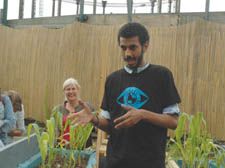|
|
 |
| |

Growing: Zak Lur and Jane Riddiford |
Growing imaginations
Global Generation works with the young in a unique project,Tom Moggach reports
THRIFTY gardeners scavenge for materials in skips, but Global Generation takes it one step further – they recycle the skip itself to create a mobile veg patch.
This environmental charity, based in Kentish Town, runs several gardening projects across Camden. They work with “Generators”, their team of young people from nearby schools.
I visited their skip garden on Monday evening, as part of a tour around growing sites in King’s Cross.
The five skip gardens are on Pancras Road, opposite Saint Pancras station. Have a peek if you’re passing – there are windows in the wooden wall down towards Camley Street.
They’ve just been built by Generators and staff from the Guardian newspaper. “It was really hard work, but I enjoyed it,” said Zak Lur, 16.
I asked if many of his mates were willing to get their hands dirty.
“They need a push a nudge to get into it,” he replied.
Each skip has wooden steps with raised beds built inside. You walk right into the skip and garden at a sensible height. Three are for growing veg, another is a custom-built polytunnel and the last is for a compost bin and wormery. “It’s not just soil in a tin box,” said Jane Riddiford of Global Generation. “As far as we know, it’s the first of its type.”
The produce will be used in Konstam, a local restaurant, and the Guardian canteen.
There are also plans for a small orchard of fruit trees. Interestingly, they will be of the “ballerina” or “minaret”’ types. They are compact trees which have been developed to grow on one vertical stem, ideal for small patios or gardens. You can even buy trees which have two varieties of apple, pear or plum growing together, one above the other. Check out fruit nursery () for more details.
Our next stop was the roof garden at Wolff Olins, a brand consultancy company (not open to the public).
Started last year, it consists of four shallow raised beds. Inside, there are three taller planters made of woven willow to keep the weight to a minimum. Some of the compost was provided by Aardvark Recycling, a social enterprise which collects food waste and turns it into compost ().
Crops include herbs, strawberries, courgettes, cabbages, Swiss chard, peas and broad beans, for use in the office kitchen. “It’s the freshness of ingredients that count,” said building manager Stuart Robertson.
There are pros and cons to growing on rooftops. The key issues are weight, water, drainage and the aspect of the site. “The advantage is you have loads of light, and you’re above the contaminants,” said Riddiford. “It’s a great space to get your imagination growing.”
But they can also be exposed and windy – start small, and experiment with which crops will do best. If you want to create one yourself it’s sensible to get a report from a structural engineer for anything more than a few pots. For more information, go to .
I also met Generator Mariam Turay, 19, who had been working on another roof garden at the Office Group Building.
“It’s a microclimate, because the heat rises up from the building.” The rain, she added, helps and the wind aids pollination: “Some plants flower earlier than they are expected – it’s amazing. It’s easy to get stuff growing really quickly.”
As with all these projects, their success is down to teamwork. It’s best to involve people of all ages from the local community. As Riddiford put it: “Be conscious of both sides, growing plants and growing people.”
|

|
 |
Your comments:
|
|
 |
|

